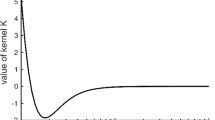Abstract.
A new theory for high-resolution regional geoid computation without applying Stokes’s formula is presented. Operationally, it uses various types of gravity functionals, namely data of type gravity potential (“gravimetric leveling”), vertical derivatives of the gravity potential (“modulus of gravity intensity from gravimetric surveys”), horizontal derivatives of the gravity potential (“vertical deflections from astrogeodetic observations”) or higher-order derivatives such as gravity gradients. Its algorithmic version can be described as follows: (1) Remove the effect of a very high degree/order potential reference field at the point of measurement (POM), in particular GPS positioned, either on the Earth’s surface or in its external space. (2) Remove the centrifugal potential and its higher-order derivatives at the POM. (3) Remove the gravitational field of topographic masses (“terrain effect”) in a zone of influence of radius r. A proper choice of such a radius of influence is 2r=4×104 km/n, where n is the highest degree of the harmonic expansion. (cf. Nyquist frequency). This third remove step aims at generating a harmonic gravitational field outside a reference ellipsoid, which is an equipotential surface of a reference potential field. (4) The residual gravitational functionals are downward continued to the reference ellipsoid by means of the inverse solution of the ellipsoidal Dirichlet boundary-value problem based upon the ellipsoidal Abel–Poisson kernel. As a discretized integral equation of the first kind, downward continuation is Phillips–Tikhonov regularized by an optimal choice of the regularization factor. (5) Restore the effect of a very high degree/order potential reference field at the corresponding point to the POM on the reference ellipsoid. (6) Restore the centrifugal potential and its higher-order derivatives at the ellipsoidal corresponding point to the POM. (7) Restore the gravitational field of topographic masses ( “terrain effect”) at the ellipsoidal corresponding point to the POM. (8) Convert the gravitational potential on the reference ellipsoid to geoidal undulations by means of the ellipsoidal Bruns formula. A large-scale application of the new concept of geoid computation is made for the Iran geoid. According to the numerical investigations based on the applied methodology, a new geoid solution for Iran with an accuracy of a few centimeters is achieved.
Similar content being viewed by others
Author information
Authors and Affiliations
Corresponding author
Additional information
Acknowledgments. The project of high-resolution geoid computation of Iran has been support by National Cartographic Center (NCC) of Iran. The University of Tehran, via grant number 621/3/602, supported the computation of a global geoid solution for Iran. Their support is gratefully acknowledged. A. Ardalan would like to thank Mr. Y. Hatam, and Mr. K. Ghazavi from NCC and Mr. M. Sharifi, Mr. A. Safari, and Mr. M. Motagh from the University of Tehran for their support in data gathering and computations. The authors would like to thank the comments and corrections made by the four reviewers and the editor of the paper, Professor Will Featherstone. Their comments helped us to correct the mistakes and improve the paper.
Rights and permissions
About this article
Cite this article
Ardalan, A., Grafarend, E. High-resolution regional geoid computation without applying Stokes’s formula: a case study of the Iranian geoid. Journal of Geodesy 78, 138–156 (2004). https://doi.org/10.1007/s00190-004-0385-2
Received:
Accepted:
Published:
Issue Date:
DOI: https://doi.org/10.1007/s00190-004-0385-2




